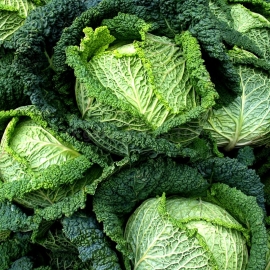



«Vertus» - Organic Savoy cabbage Seeds
1.14 €
Savoy Cabbage Vertus has a rounded head of dark green ruffled leaves that have a more subtle flavour compared to other savoy cabbages. A very hardy cabbage that stands well without splitting. Cabbages will happily grow in good sized containers.
-
Savoy cabbage «Vertus»
Savoy Cabbage Vertus has a rounded head of dark green ruffled leaves that have a more subtle flavour compared to other savoy cabbages. A very hardy cabbage that stands well without splitting.
Cabbages will happily grow in good sized containers (at least 30cm / 12 inch diameter) or planters.
How to Grow
Growing savoy cabbage is similar to growing any other cabbage. Both are cold hardy, but savoy is by far the most cold hardy of the cabbages. Plan to set out new plants in the spring early enough so they can mature before the heat of summer. Sow seeds 4 weeks before the last frost for plants to be transplanted in June and plant fall cabbage 6-8 weeks before the first frost of your area. Allow the plants to harden and acclimate to the colder temps before transplanting.
Transplant the savoy, allowing 2 feet between rows and 15-18 inches between plants in a site with at least 6 hours of sun. The soil should have a pH of between 6.5 and 6.8, be moist, well-draining and rich in organic matter for the most optimal conditions when growing savoy cabbage. If you start with these requirements, caring for savoy cabbage is fairly labor free. When caring for savoy cabbage, it’s a good idea to mulch with compost, finely ground leaves or bark to keep the soil cool, moist and retard leaves.
Keep the plants consistently moist so they don’t stress out; apply 1- 1 ½ inches of water per week depending upon rainfall. Fertilize the plants with a liquid fertilizer, such as fish emulsion, or 20-20-20 once they develop new leaves, and again when the heads begin to form. Follow these instructions and you will be eating delicious Brassica oleracea bullata sabauda (say that a few times really fast!) either fresh or cooked. Oh, and the good news about cooked savoy cabbage, it lacks the unpleasant sulfur odor that other cabbages have when cooked.
